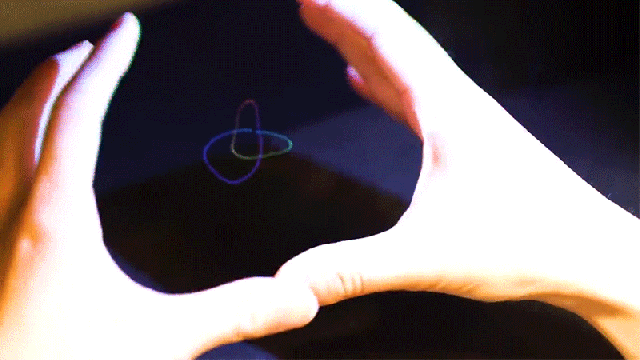Holograms are no longer just a vaguely futuristic term that helps startups secure seed money, or a way to bring deceased performers back to sell more concert tickets. Researchers at the University of Sussex have created animated 3D holograms that can not only be seen from any angle, they can also be touched, bringing us one small step closer to Star Trek’s holodecks.
The researchers took an approach that was similar to one pioneered by engineers at Utah’s Brigham Young University who used invisible lasers to levitate and manipulate a small particle in mid-air, which was illuminated with RGB lights as it zipped around to create the effect of a 3D image. What’s different with the University of Sussex’s holograms is that instead of lasers, two arrays of ultrasonic transducers generating soundwaves are used to float and control a lightweight polystyrene bead just two millimetres in size.
Like an old-school CRT TV which used an electron gun strafing across a screen to light up individual pixels faster than the human eye could tell they all weren’t glowing at the same time, the soundwaves from the ultrasonic transducers are manipulated to move the bead at speeds of up to 32 kilometres per hour, tracing out a shape as large as 10 centimetres across in less than a tenth of a second. That’s faster than the human eye can track, meaning a viewer only sees a completed three-dimensional shape. And because they genuinely exist in 3D space, and aren’t just a two-dimensional image that appears to have a third dimension by tricking the brain through optical illusions, these holograms can be viewed from any angle without any degradation of the effect.
The technology isn’t limited to just creating a neat effect for the eyes. In addition to zipping the foam bead around to create the outlines of shapes, the transducers can also make it vibrate at frequencies that create soundwaves, particularly those that fall within the range of human hearing. So not only could the bead be manipulated to create the image of a talking face, but it could also function as a tiny speaker so the face talked too. But that’s not all. The researchers believe they could take things one step further to create ultrasonic soundwaves at frequencies that could be felt as a tactile sensation. The flapping wings of a butterfly in flight could be felt if someone placed their hands close enough to the hologram.
It’s not quite the hyper-realistic holographic simulations the crew of the USS Enterprise enjoyed on their off-time in Star Trek: The Next Generation—that supposedly employed advanced force fields and other technologies we’re nowhere near perfecting. But as a way to explore virtual worlds or 3D video games, I’d happily choose this new hologram tech over a clunky pair of VR goggles.
